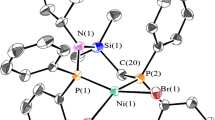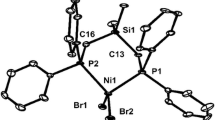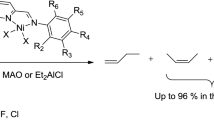Abstract
A computational study utilizing density functional theory (DFT) was performed to analyze the mechanism of ethylene dimerization catalyzed by (P,N) nickel(II) complexes, where (P,N) is a mixed phosphine–iminophosphorane ligand. Two plausible reaction pathways were considered, namely the Cossee and metallacycle pathways, for three model systems. The fundamental role of ligand assymetry and the importance of steric and trans effects were elucidated. In order to discriminate between both mechanisms, the activation of the precatalyst by trimethylaluminum was modeled. The results obtained allow the establishment of useful guidelines for creating new specifically tailored nickel-based catalysts for controlled dimerization.








Similar content being viewed by others
Notes
Note that the reported transition state for elimination is the one associated with hydrogen transfer to the metal, which is the first step in butene elimination. The second step involves the release of butene by replacing the still-coordinated C4H8 with a C2H4 molecule. This step could only be modeled by a dynamic approach, so the point at −18.8 kcal mol−1 on the butene elimination path is obviously not meaningful and erroneously suggests that this elimination is reversible. However, as the ethylene is maintained at a high pressure (30 bars), the probability of another C4H8 coordinating is almost null.
References
Vogt D (1996) In: Cornils B, Hermann WA (eds) Applied homogeneous catalysis with organometallic compounds, vol 1. Wiley, Weinheim, pp 245–258
Lappin GR, Sauer JD (1989) Alpha-olefins applications handbook. Marcel Dekker, Berkeley
Kaminsky W, Arndt M (1996) In: Cornils B, Hermann WA (eds) Applied homogeneous catalysis with organometallic compounds, vol 1. Wiley, Weinheim, pp 220–236
Köhn RD, Haufe M, Kociok-Kohn G, Grimm S, Wasserscheid P, Keim W (2000) Selective trimerization of α-olefins with triazacyclohexane complexes of chromium as catalysts. Angew Chem Int Ed 39:4337–4339
Carter A, Cohen SA, Cooley NA, Murphy A, Scutt J, Wass DF (2002) High activity ethylene trimerisation catalysts based on diphosphine ligands. Chem Commun 858–859
Bollmann A, Blann K, Dixon JT, Hess FM, Killian E, Maumela H, McGuinness DS, Morgan DH, Neveling A, Otto S, Overett M, Slawin AMZ, Wasserscheid P, Kuhlmann S (2004) Ethylene tetramerization: a new route to produce 1-octene in exceptionally high selectivities. J Am Chem Soc 126:14712–14713
McGuinness DS, Wasserscheid P, Morgan DH, Dixon JT (2005) Ethylene trimerization with mixed-donor ligand (N,P,S) chromium complexes: effect of ligand structure on activity and selectivity. Organometallics 24:552–556
Agapie T, Day MW, Henling LM, Labinger JA, Bercaw JE (2006) A chromium-diphosphine system for catalytic ethylene trimerization: synthetic and structural studies of chromium complexes with a nitrogen-bridged diphosphine ligand with ortho-methoxyaryl substituents. Organometallics 25:2733–2742
Elowe PR, McCann C, Pringle PG, Spitzmesser SK, Bercaw JE (2006) Nitrogen-linked diphosphine ligands with ethers attached to nitrogen for chromium-catalyzed ethylene tri- and tetramerizations. Organometallics 25:5255–5260
Jabri A, Crewdson P, Gambarotta S, Korobkoc I, Duchateau R (2006) Isolation of a cationic chromium(II) species in a catalytic system for ethylene tri- and tetramerization. Organometallics 25:715–718
Schofer SJ, Day MW, Henling LM, Labinger JA, Bercaw JE (2006) Ethylene trimerization catalysts based on chromium complexes with a nitrogen-bridged diphosphine ligand having ortho-methoxyaryl or ortho-thiomethoxy substituents: well-defined catalyst precursors and investigations of the mechanism. Organometallics 25:2743–2749
McGuinness DS, Rucklidge AJ, Tooze RP, Slawin AMZ (2007) Cocatalyst influence in selective oligomerization: effect on activity, catalyst stability, and 1-hexene/1-octene selectivity in the ethylene trimerization and tetramerization reaction. Organometallics 26:2561–2569
Svejda SA, Brookhart M (1999) Ethylene oligomerization and propylene dimerization using cationic (α-diimine)nickel(II) catalysts. Organometallics 18:65–74
Tellman KP, Gibson VC, White AJP, Williams DJ (2005) Selective dimerization/oligomerization of α-olefins by cobalt bis(imino)pyridine catalysts stabilized by trifluoromethyl substituents: group 9 metal catalysts with productivities matching those of iron systems. Organometallics 24:280–286
Speiser F, Braunstein P, Saussine L (2005) Catalytic ethylene dimerization and oligomerization: recent developments with nickel complexes containing P, N-chelating ligands. Acc Chem Res 38:784–793
Lejeune M, Semeril D, Jeunesse C, Matt D, Peruch F, Lutz PL, Ricard L (2004) Diphosphines with expandable bite angles: highly active ethylene dimerisation catalysts based on upper rim, distally diphosphinated calix[4]arenes. Chem Eur J 10:5354–5360
Ajellal N, Kuhn MCA, Boff ADG, Horner M, Thomas CM, Carpentier JF, Casagrande OL (2006) Nickel complexes based on tridentate pyrazolyl ligands for highly efficient dimerization of ethylene to 1-butene. Organometallics 25:1213–1216
Buchard A, Auffrant A, Klemps C, Vu-Do L, Boubekeur L, Le Goff XF, Le Floch P (2007) Highly efficient P–N nickel(II) complexes for the dimerisation of ethylene. Chem Commun 1502–1504
Boubekeur L, Ricard L, Mézailles N, Le Floch P (2005) Synthesis of new mixed phosphineiminophosphorane bidentate ligands and their coordination to group 10 metal centers. Organometallics 24:1065–1074
Boubekeur L, Ricard L, Mézailles N, Demange M, Auffrant A, Le Floch P (2006) Nitrogen-assisted ortho lithiation: one-pot synthesis of new classes of bidentate and tetradentate mixed P∼N ligands. Organometallics 25:3091–3094
Koch W, Holthausen MC (2000) A chemist’s guide to density functional theory of atoms and molecules. Wiley-VCH, Weinheim
Parr RG, Yang W (1989) Density functional theory of atoms and molecules. Oxford University Press, New York
Ziegler T (1995) The 1994 Alcan Award Lecture: density functional theory as a practical tool in studies of organometallic energetics and kinetics. Beating the heavy metal blues with DFT. Can J Chem 73:743–761
Morokuma K, Musaev DG (2008) Computational modeling for homogeneous and enzymatic catalysis: a knowledge-base for designing efficient catalysts. Wiley-VCH, Weinheim
Fan L, Krzywicki A, Somogyvari A, Ziegler T (1994) Density functional study of ethylene dimerization by (Acetylacetonato)nickel hydride Inorg Chem 33:5287–5294
Bernardi F, Bottoni A, Rossi I (1998) A DFT investigation of ethylene dimerization catalyzed by Ni(0) complexes. J Am Chem Soc 120:7770–7775
Shiotsuki M, White PS, Brookhart M, Templeton JL (2007) Mechanistic studies of platinum(II)-catalyzed ethylene dimerization: determination of barriers to migratory insertion in diimine Pt(II) hydrido ethylene and ethyl ethylene intermediates. J Am Chem Soc 129:4058–4067
Cossee P (1964) Ziegler–Natta catalysis. I. Mechanism of polymerization of α-olefins with Ziegler–Natta catalysts. J Catal 3:80–88
Fink G, Mülhaupt R, Brintzinger H (1995) Ziegler catalysts. Springer, Berlin
Tempel DJ, Johnson LK, Huff RL, White PS, Brookhart M (2000) Mechanistic studies of Pd(II): α-diimine-catalyzed olefin polymerizations. J Am Chem Soc 122:6686–6700
Leatherman MD, Svejda SA, Johnson LK, Brookhart M (2003) Mechanistic studies of nickel(II) alkyl agostic cations and alkyl ethylene complexes: investigations of chain propagation and isomerization in (α-diimine)Ni(II)-catalyzed ethylene polymerization. J Am Chem Soc 125:3068–3081
Liu WJ, Brookhart M (2004) Mechanistic studies of palladium(II)-α-diimine-catalyzed polymerizations of cis- and trans-2-butenes. Organometallics 23:6099–6107
Bianchini C, Giambastiani G, Rios IG, Mantovani G, Meli A, Segarra AM (2006) Ethylene oligomerization, homopolymerization and copolymerization by iron and cobalt catalysts with 2,6-(bis-organylimino)pyridyl ligands. Coord Chem Rev 250:1391–1418
Emrich R, Heinemann O, Jolly PW, Kruger C, Verhovnik GPJ (1997) The role of metallacycles in the chromium-catalyzed trimerization of ethylene. Organometallics 16:1511–1513
Overett MJ, Blann K, Bollmann A, Dixon JT, Haasbroek D, Killian E, Maumela H, McGuinness DS, Morgan DH (2005) Mechanistic investigations of the ethylene tetramerisation reaction. J Am Chem Soc 127:10723–10730
Frisch MJ et al. (2003) Gaussian 03, revision B.05. Gaussian, Inc., Pittsburgh
Becke AD (1993) Density–functional thermochemistry. III. The role of exact exchange. J Chem Phys 98:5648–5652
Poater A, Solans-Monfort X, Clot E, Coperet E, Eisenstein O (2007) Understanding d 0-olefin metathesis catalysts: which metal, which ligands? J Am Chem Soc 129:8207–8216
Guihaumé J, Halbert S, Eisenstein O, Perutz RN (2012) Hydrofluoroarylation of alkynes with ni catalysts. C–H activation via ligand-to-ligand hydrogen transfer, an alternative to oxidative addition. Organometallics 31:1300–1314
Hay PJ, Wadt WR (1985) Ab initio effective core potentials for molecular calculations. Potentials for the transition metal atoms Sc to Hg. J Chem Phys 82:270–283
Cho HG, Cheong BS (2009) Agostic interaction of the smallest zirconium methylidene hydride: reproduction of the distorted structure experimentally observed in matrix infrared spectra. Bull Korean Chem Soc 30:479–481
Vidal I, Melchor S, Alkorta I, Elguero J, Sundberg MR, Dobado JA (2006) On the existence of α-agostic bonds: bonding analyses of titanium alkyl complexes. Organometallics 25:5638–5647
Virkkunen V, Pietilä LO, Sundholm F (2003) DFT investigation of the regiospecifity of a model catalyst site for propene polymerisation. Polymer 44:3133–3139
Fukui K (1981) The path of chemical reactions: the IRC approach. Acc Chem Res 14:363–368
Gonzalez C, Schlegel HB (1990) Reaction path following in mass-weighted internal coordinates. J Phys Chem 94:5523–5527
Liang L-C, Chien PS, Lee P-Y (2008) Phosphorus and olefin substituent effects on the insertion chemistry of nickel(II) hydride complexes containing amido diphosphine ligands. Organometallics 27:3082–3093
Chen EYX, Marks TJ (2000) Cocatalysts for metal-catalyzed olefin polymerization: activators, activation processes, and structure−activity relationships. Chem Rev 100:1391–1434
Sinn H, Kaminsky W (1980) Ziegler–Natta catalysis. Adv Organomet Chem 18:99–149
Johnson LK, Killian CM, Brookhart M (1995) New Pd(II)- and Ni(II)-based catalysts for polymerization of ethylene and α-olefins. J Am Chem Soc 117:6414–6415
Musaev DG, Froese RDJ, Svensson M, Morokuma K (1997) A density functional study of the mechanism of the diimine−nickel-catalyzed ethylene polymerization reaction. J Am Chem Soc 119:367–374
Margl P, Deng LQ, Ziegler T (1999) A unified view of ethylene polymerization by d 0 and d 0 f n transition metals. 3. Termination of the growing polymer chain. J Am Chem Soc 121:154–162
Talarico G, Budzelaar PHM (2006) A second transition state for chain transfer to monomer in olefin polymerization promoted by group 4 metal catalysts. J Am Chem Soc 128:4524–4525
Tellmann KF, Humphries MJ, Rzepa HS, Gibson VC (2004) Experimental and computational study of β-H transfer between cobalt(I) alkyl complexes and 1-alkenes. Organometallics 23:5503–5513
Grubbs RH, Miyashita A (1978) Metallacyclopentanes as catalysts for the linear and cyclodimerization of olefins. J Am Chem Soc 100:7416–7418
McKinney RJ, Thorn DL, Hoffmann R, Stockis A (1981) Nickelacyclopentane complexes. A theoretical investigation. J Am Chem Soc 103:2595–2603
Hsiao J, Su M-D (2008) Theoretical characterizations of the ring expansion of a metallacyclopropane to a metallacyclopentane. Organometallics 27:4139–4146
Klein H-F, Bickelhaupt A, Lemke M, Jung T, Röhr C (1995) Synthesis and structure of octahedral nickel(IV) complexes containing two chelating acylphenolato ligands. Chem Lett 24:467–468
Patra AK, Mukherjee R (1999) Direct detection of aqueous diazene: its UV spectrum and concerted dismutation. Inorg Chem 38:1388–1393
Dimitrov V, Linden A (2003) A pseudotetrahedral, high-oxidation-state organonickel compound: synthesis and structure of bromotris(1-norbornyl)nickel(IV). Angew Chem Int Ed 42:2631–2633
Blok ANJ, Budzelaar PHM, Gal AW (2003) Mechanism of ethene trimerization at an ansa-(arene)(cyclopentadienyl) titanium fragment. Organometallics 22:2564–2570
Brückner A, Jabor JK, McConnell AEC, Webb PB (2008) Monitoring structure and valence state of chromium sites during catalyst formation and ethylene oligomerization by in situ EPR spectroscopy. Organometallics 27:3849–3856
Bianchini C, Gatteschi D, Giambastiani G, Guerrero Rios I, Ienco A, Laschi F, Mealli C, Meli A, Sorace L, Toti A, Vizza F (2007) Electronic influence of the thienyl sulfur atom on the oligomerization of ethylene by cobalt(II) 6-(thienyl)-2-(imino)pyridine catalysis. Organometallics 26:726–739
Zurek E, Ziegler T (2002) Toward the identification of dormant and active species in MAO (methylaluminoxane)-activated, dimethylzirconocene-catalyzed olefin polymerization. Organometallics 21:83–92
Janse van Rensburg W, van den Berg J-A, Steynberg PJ (2007) Role of MAO in chromium-catalyzed ethylene tri- and tetramerization: a DFT study. Organometallics 26:1000–1013
Tognetti V, Le Floch P, Adamo C (2010) How the choice of a computational model could rule the chemical interpretation: the Ni(II) catalyzed ethylene dimerization as a case study. J Comput Chem 31:1053–1062
Tognetti V, Fayet G, Adamo C (2010) Can molecular quantum descriptors predict the butene selectivity in nickel(II) catalyzed ethylene dimerization? A QSPR study. Int J Quantum Chem 110:540–548
Acknowledgments
The CNRS (Centre National de la Recherche Scientifique), the Ecole Polytechnique, the Ecole Nationale Supérieure de Chimie, and the IDRIS (Institut du Développement et des Ressources en Informatique; for computer time, projects no. 171616 and 72115) are thanked for supporting this work. This paper is dedicated to the memory of Pascal Le Floch, who initiated the collaborative work between our groups.
Author information
Authors and Affiliations
Corresponding author
Additional information
The author Pascal Le Floch is now deceased.
Rights and permissions
About this article
Cite this article
Tognetti, V., Buchard, A., Auffrant, A. et al. Ethylene dimerization catalyzed by mixed phosphine–iminophosphorane nickel(II) complexes: a DFT investigation. J Mol Model 19, 2107–2118 (2013). https://doi.org/10.1007/s00894-012-1631-9
Received:
Accepted:
Published:
Issue Date:
DOI: https://doi.org/10.1007/s00894-012-1631-9




